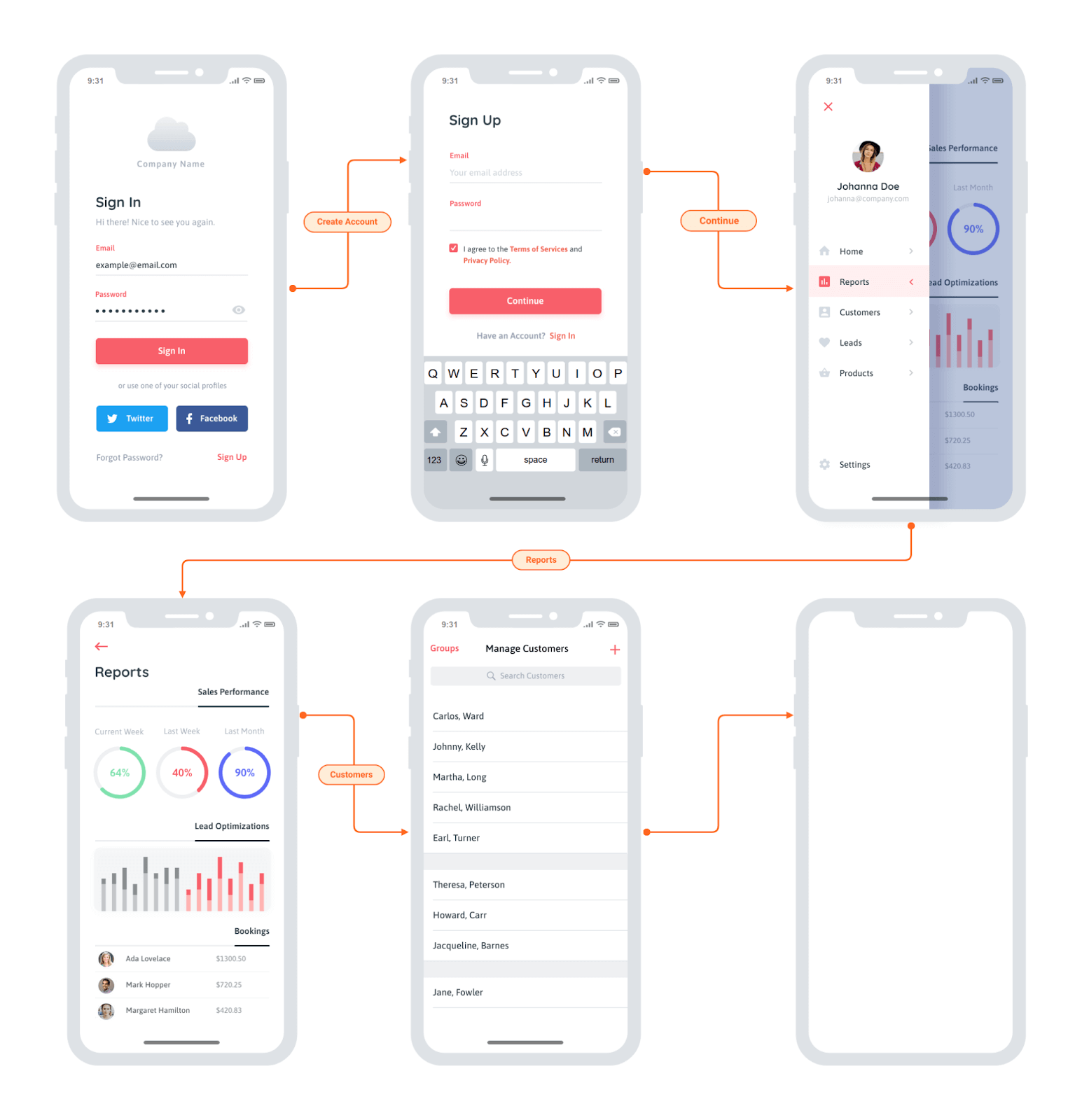Have an idea? Looking to develop an app for the first time? Want to make money out of it?
Have questions like:
- What will be the cost of mobile app development?
- How to earn money from the application?
- How will the app get more downloads?
- Which important features should be included in the app?
- How often should the mobile app be updated?
If yes, this guide is for you.
To make you understand the complete process and clear your doubts, we have drafted an in-depth blog about the mobile application development process. To simplify each step, we took help from our experienced mobile app developers and consultants who have developed enterprise-level apps.
Table of Contents
Step-by-step Guide on Mobile App Development Process
The demand for a mobile app is increasing, and this fact is confirmed by the report of Statista.
- Android has 3.48 million apps on Play Store
- App Store has approximately 2.22 million available apps for iOS
Most companies try to take advantage of this trend but are not aware of the mobile app development process steps and its importance.
So if you are developing an app for the first time, you must know the mobile app development stages because:
- It reduces the cost of app development since you know the expectation and purpose of each phase
- Provides a general idea of the time taken in every stage
- Easy to define key milestones
- You can set goals and strategize the development accordingly
So, let’s understand the complete iOS and Android mobile app development process to get the gist of how the app is developed.
Phase 1: Market Research and Understanding the Project Requirements

To make an app from scratch, first step of the mobile application development steps involves gathering information that helps to plan the roadmap. This phase aims to understand the idea, purpose of the mobile app development, business logic, objectives, and competitors’ shortcomings.
To gather the requirements, you’ll need to answer the following questions:
- Who will use this app? Who are the ideal customers?
- Who are the competitors?
- How do the competitors’ deliver their service? Does their process differ?
- What are the pain points and challenges in the existing apps?
- What do you want to accomplish with this mobile app?
- What is the USP of your mobile app?
Answering these questions helps to shape your app idea, define a cost estimation, and set the delivery milestones as per your project requirements.
The more you understand the whereabouts of the mobile app, the better credible result it will deliver. Therefore, it is recommended to do a detailed analysis and basic groundwork of the above questions before moving to the next phase.
Apart from this, you might have questions like:
Which Platform Do You Need to Choose for App Development?
Choosing the platform depends on your requirements and the features of the mobile app. Most of the apps require different technology stacks.
Discuss your mobile app requirements with one of the best app development companies in Canada that have experience in developing similar applications.
With the help of consultation from mobile app development professionals, it’d be easier for you to understand which platform to choose for mobile app development; native apps (iOS app or Android app) or hybrid apps.
Once you select the app development platform, you must consider recent technology trends.
Why?
Because most of the audience prefers to go with the latest trends.
Which Recognizable and Unique Name Can You Give to Your Mobile App?
Find a name that is short, memorable, searchable, and unique. Most of the successful apps have one-word names, which helps the users to remember easily. For instance: WhatsApp, Telegram, Skype, and Snapchat.
Phase 2: Analyze the Competition

After gathering the requirements and doing market research, analyze the competitor’s app – how they function, what are their strengths and weaknesses, and figure out the gap between the competitor’s app and your mobile app.
This phase in the mobile app development process aims to define the detailed functional requirement of the app. For the app’s success, develop a unique app concept and identify the features and functionalities you would implement in it.
When you analyze the competition, you may have questions like:
How to Do the Competitors Analysis?
- Pick the right competitors to analyze
- Understand the aspects of competitors’ that are worth analyzing
- Know the competitor’s data and identify their strength, weaknesses, opportunities, and threats
- Understand how you can use competitors’ insights to improve the business
Why Do a Competitor Analysis?
If competitor analysis is done properly, you get qualitative and quantitative data to support your business decision. It helps you:
- Develop your unique value proposition
- Prioritize your product development by focusing on competitors’ products
- Improve your product by understanding the competitor’s weaknesses
- Create a product category by identifying gaps between what your competitor offers and customer needs
Phase 3: Validate Your Mobile App Idea

Before moving forward in the app development process, how about doing a feasibility study of your idea? You might think that your idea is a good one; it solves a specific problem, but have you seen its output?
The purpose of this phase in the application development life cycle is to make sure your creative mobile app development ideas are valid and hold importance in the market.
Build Minimum Viable Product (MVP) Version of the App Idea
MVP is the basic version of the app, which has the core features for early customers. The app is released in the market only after getting sufficient feedback.
For instance: Spotify, one of the most popular music streaming service providers, launched MVP for a closed group of Windows users. Having received considerable feedback from the first customers, the Spotify founders- Daniel EK and Martin Lorentzon proved that their service would generate a considerable income. Today, Spotify has 155 million active users and 155 million premium Spotify subscribers.
Many other successful start-ups have validated their mobile app development idea by developing MVP before commencing with the final version.
Check this guide about MVP version mobile apps if you want to explore more on it.
- Reduces the risk of developing the mobile app
- Saves time during the actual development
- Proves that your idea has an actual demand
- Provide feedback for the future development of the product
- Boost the confidence to sell the product
- Conduct market research
- Build Minimum Viable Product
- Analyze the mobile application store charts
- Understand the size of the target market
- Check whether a product will fit in the market
Have an App Idea in Mind?
Share your requirements with us and our IT consultants will guide you on how to proceed further.

Phase 4: Sign a Non-disclosure Agreement (NDA) to Protect Your App Idea

Sign an NDA if you have frozen your requirements with the app development company. Data privacy is of utmost importance in the app development process. Thus, you need to make sure it is not shared in public.
Let’s understand the what, why, and importance of NDA.
What is an NDA?
NDA is a confidential agreement signed between two parties that agrees upon not disclosing or sharing certain information in public. If information is breached, legal actions are taken.
Why Sign an NDA During the Mobile App Development Process?
On signing an NDA, two parties commit to secure the app idea and other sensitive information. There are many software available through which app ideas, business strategies, and confidential information are automatically encrypted, stored, and securely backed up. In addition, most app development companies have dedicated teams to guide clients throughout the agreement.
What Does the Agreement Contain?
Most of the agreements contain- project requirements, communication methods, meeting data, legal clauses, the time frame of the agreement, and delivery phases in milestones.
What is the Importance of Signing the NDA?
- Provides confidence to share confidential information
- Ensures clarity on what information is confidential
- Helps to preserve a critical business relationship
How to Patent an App Idea?
Have an exclusive app idea? Afraid about someone stealing it?
Patenting can shield your app idea and keeps the copiers away from stealing or using it. To patent it, your app idea should be new and exclusive to the subject to patent law.
Phase 5: Wireframing of Mobile App

Once the company is agreed to sign an NDA, the team of business analysts will start wireframing the app to understand what the app will look like.
Wireframing is the visual representation of the app concept. The primary purpose of this phase in the mobile app development process is to provide a clear outline of the screen structure, layout, navigation of the entire app, and the relationship between each screen and features.
Wireframes can be hand-drawn with pen and paper or by using wireframing tools like Balsamiq, Axure, Mockplus, and Sketch.
This is what a wireframe looks like.
Let’s understand the reasons to use wireframes and the tools used in wireframes.

Source: Moqups
Why is Wireframing Useful?
- Identifies the missing needs
- Get an overview of a mobile app flow
- Estimates the project development with more accuracy
- Helps to deliver the core message effectively
- Gathers feedback at an early stage
- Gives a clear picture of the elements that are needed to code
- Saves time on the entire project
Here are the Tools Required for Wireframing
- Balsamiq
- Moqups
- Adobe
- Sketch
How Much Time Does it Take to Wireframe the Mobile App?
Wireframing of the mobile app takes 2-3 days. However, it also depends on the scope and requirement of the mobile app.
Phase 6: Designing the UI/UX of the Mobile Apps

App design combines the UI and UX of an app; while UI is the overall style (color, fonts, buttons, controls) of the app, UX defines usability and functionality.
In the mobile app development process, the purpose of UI/UX is to provide easy and effective interaction between mobile apps and users. In addition, UI/UX puts a lasting impact on the user’s mind, thereby boosting the conversion rate and growing the brand name.
Want to know more about designing. Let’s understand why, tools, and tips for good design.
Why UI/UX is Important?
- Increase customer retention
- It gives the blue-print and visual direction of the entire app
- Improves the average time spent by the visitor, which may result in conversion, and interaction
- Improves brand perception
- Boost search-engine ranking
- Clarifies the vision
- Draws the attention of users
Which Tools do Graphic Designers Use for Designing the App?
- Adobe XD
- Sketch
- Photoshop
- InVision Studio
- Marvel
- Figma
Want to know more about the app design tools? Here’s a complete list of app designing tools.
What Makes a Good Mobile App Design?
Apps that are not designed well simply won’t succeed. Check out the below-mentioned to know what we recommend.
- Maintain buttons, typefaces, labels similar across entire app
- Use clear images
- Make navigation easy
- Don’t make random color choices
- Use the elements that have clear purpose
- Too many design elements can make app complicated
- Don’t pick up fancy fonts
- Keep design responsive
How Much Time Does it Take to Design an App?
Designing the UI/UX of a mobile app takes around 1- month. However, designing mobile apps depends on the requirements, number of screens, features, and complexity. Have a look at the table to understand how much time we take to design simple, medium, and complex apps.
| App Type | Examples | Design Time |
|---|---|---|
| Simple App | Calculator, formula based calculations, simple image editor with inbuilt filter SDK | 1-2 weeks |
| Complex App | OnDemand applications like Uber eats, Postmates. Booking applications like airbnb, bookings.com – Video editors like Apple clips, FilmoraGo | 2-3 weeks |
| Enterprise App | Large scale applications with multiple SDKs and custom SDKs E-Commerce application like Amazon, Walmart Streaming applications like Netflix Spotify | 3-4 weeks |
Phase 7: Mobile App Development

After defining the app’s skeleton, your app is ready to move into the programming and coding phase. Development is an iterative phase where development work is broken into smaller milestones to build an app. In this phase of the native app development process, continuous changes happen until the expected result is delivered.
Space-O Technology has top mobile app developers on board who handle every aspect of the development precisely. So hire mobile app developers to smoothen your app development process.
In fact, by following the app development process, we have developed more than 300 mobile app solutions including an on-demand app like UpMaid, a photography app, and a taxi app.
What is the General Architecture for App Development?
The mobile app development process includes frontend and backend development to complete developing a mobile application.
Front-end Development: Front-end of the mobile app is what the user experiences and interacts with the mobile app. There are two types of front-end developments:
a) Native front-end development is designed for iOS (developed with Objective-C or Swift) or Android platforms (developed with Java or Kotlin).
b) Hybrid is used for both and is compatible with all operating system
Following is the technology stack we use for front-end development:
- HTML
- CSS3
- JavaScript
- AngularJS
- ReactNative
- Flutter
Back-end Development: As the name says, it handles the behind-the-scenes of the entire application. Backend development focuses on storing information in databases and creating an architecture, making it easy to retrieve it.
For instance: Signups, logins, messaging, storing data on the cloud, answering user queries happen in the backend. Amazon, Uber, Netflix require a backend.
Following is the web programming language stack for back-end development:
- PHP
- JavaScript
- Python
- Ruby-on-Rails
What is App Delivery Milestone?
At the beginning of the project, the development process is broken down into different steps and deadlines for each step are defined. Each completed step is known as a milestone.
Development of the app is done in milestones so that you know the expectations, dates to be delivered, and track of progress to complete the project on time and within budget.
For instance: Milestone 1 in development phase
- Registration and login
- Integration of social networks
- Message interface
- Push notifications
- Account settings
- Design implementation
Phase 8: Mobile App Testing

Mobile app testing is the process of testing the functionality and usability of a mobile app. In the mobile app development lifecycle phase, the quality analyst team prepares the test cases to evaluate the app quality and record the test results. Testing can be manual or automated and helps to ensure that applications, i.e., delivered are error-free and meet the business requirements.
With agile processes, app testing is performed often to assure the best possible quality. In the testing phase, new features and bug fixes are released at short intervals. This type of testing in the app development process ensures that there are no bugs when the app is live and used by the app users.
Let’s understand more about specific things required for testing, the tools used, and the importance of testing.
What Specific Things to Consider Before Testing Mobile Apps?
- Screen resolution
- Turning on/off GPS
- Screen orientation (Landscape or Portrait)
- Different device manufacturers
- Operating system
- Type of mobile application
Which Tools are Used to Perform Testing?
To assure the performance and code stability, testing tools are used. Here are some of the tools that can be used:
- Selenium
- Load runner
- Appium
- Apache Jmeter
- Cucumber
Benefits of Quality Assurance for Your Mobile App
- Identifies the quality of the mobile app
- Identifies the gaps, or missing requirements contrary to actual requirements
- Improves time-to-market
- Reduces development and maintenance cost
- Improves overall performance of the app
How Much Time Does it Take to Test the Application?
Mobile app testing takes anywhere between 1 month – 2 months. It may even take longer if there are problems with the app or if the app is complex.
Phase 9: Launching of Mobile App

If the app is successfully developed, then you are ready to launch it in the market. Depending on your goals, your app is either launched on App Stores or Google Play Store, or both. However, before the app launch, it is required to fulfill certain criteria, rules, requirements, and policies of Apple’s App Store or Play Store.
- Title of the app
- Metadata
- Description
- Category
- Keywords
- Launch icons
- Screenshots
- Images/videos
For the app release, you would require
Once your app is submitted to the Apple App Store, iOS apps are reviewed based on quality and guidelines. It generally takes around a few days – to weeks to approve the app. If your app gets rejected, you can communicate with the Apple Resolution center.
In Google Play Store, it takes up to seven days or longer in exceptional cases to publish the app. For certain developer accounts, it may take more time to thoroughly review the app to protect the users. You will receive a notification on your app’s dashboard about how long your app will take.
- Perform application store optimization to create awareness amongst the target audience
- Perform SEO to optimize the keywords to be used in the app marketing
- Create the landing page to promote your app efficiently
- Opt for a paid advertising to increase the app’s reach
Some key areas to focus on after launching in the app development process:
Want to Hire the Best Mobile App Developers?
Contact our app development team. We have experience in developing over 300 iOS and Android mobile apps.
Phase 10: Maintenance and Upgradation of App

Once the app is launched in the stores, it is essential to measure the app analytics. Track KPI and check crash reports or other user-reported issues for measuring the success of the app.
Encourage users to give feedback and reviews as it will be helpful for future versions of the app. Moreover, upgrade the app at regular intervals as it is one reason for app failure or app uninstalls.
According to a report, 1 million risky apps were rejected by the Apple App Store in 2020.
Numbers show that, while there is a rise in the number of published mobile apps, the obsolete apps are equally getting removed.
Why is it Important to Maintain and Upgrade Mobile apps?
- To stay relevant
- To fix bugs
- Provides security against cyber threats
- Avoids unfortunate downtime
- Helps to stay competitive
- To keep up with the technology
- For the purpose of rebranding
Best Practices for Mobile App Maintenance
- Track the app performance
- Update the user interface at regular intervals
- Use the latest technology stack
- Fix the bugs
- Add new features and functionalities
How Much Does it Cost to Maintain the App?
Maintaining the cost of app development takes around $3000-$5000 /month/platform with a minimum 6-month contract to maintain the app.
If you want to know in detail about the cost to maintain an app we have written a detailed guide on how much it costs to maintain an app.
Have doubts about the mobile app development process? Want to know more about it? Let’s check frequently asked questions.
FAQ About Mobile App Development Process
Which tools are used during the mobile app development process?
In the mobile app development cycle, every phase requires different tools:
- Basecamp for project communication
- Adobe tools & sketch for design tools
- Android Studio, Xcode, Visual studio, intelIJ idea for development
- Mantis, SonarQube for bugs and scanning
- Appium & Jcenter for Automation & testing
- GitLab for version controlling mechanism
- Jenkins for CI
- Swagger for API development
How much time will it take to develop an app?
Developing mobile applications depends on the mobile app’s functionality, complexity, app market, requirements, the platform you have chosen, and your project’s structure. All stages of app development take a different amount of time to complete.
App Type Examples Development Time Simple App Calculator, formula based calculations, simple image editor with inbuilt filter SDK 3-4 weeks Medium App OnDemand applications like Uber eats, Postmates. Booking applications like airbnb, bookings.com
Video editors like Apple clips, FilmoraGo5-6 weeks Complex App Large scale applications with multiple SDKs and custom SDKs E-Commerce application – Amazon, Walmart – Streaming applications, Netflix Spotify 8-10 weeks Which platform to choose for mobile application development?
Native mobile apps (Android or iOS) or hybrid mobile apps all depend on your requirements and needs. While choosing the platform, you should focus on:
- Target audience
- App market
- User behaviour
- Features
- The cost of development
- Devices you need to support
- App design
- User expectations
What are the best technologies that impact the app development cost?
For Android development, our development team use the following technology stack:
Programming language: Java, Kotlin
IDE: Android Studio
Database: SQLite, Realm
Tools: Android SDK, Android NDKFor iOS development, we use the following technologies.
Language: Swift, Objective C
IDE: XCode
Database: SQLite, Realm, CoreDataWhat is the cost of mobile app development?
The cost of developing a mobile app ranges from $8000 to $20000.
However, the cost of developing a mobile app depends on requirements, the type of app you want to develop, functional requirements, and the platform you choose. Below is the table of a tentative app development cost.
Simple App $8000-$10000 Medium App $12000 – $20000 Complex App $20000+
Get Started with Mobile App Development
We have summarized different phases of the mobile application development process which can help you to develop feature-rich mobile applications. From requirement gathering to app maintenance in the mobile app development process, every phase has its importance. Thus, mobile app developers need to understand each stage before commencing with the development of the mobile app.
We hope all this information about the mobile app development process helps to make the right decision. Since you have an idea about the mobile app development lifecycle, you can hire an app development team or freelancing iOS and Android developers.
You can also hire our talented pool of mobile app development team who have experience in delivering enterprise-level apps. The developers of Space-O Canada have delivered more than 300 projects across the globe. In fact, we’ve developed apps for enterprise and SMBs across most of the industry verticals.
Get in touch with us through the contact us form, and one of our sales representatives will get back to you shortly.
 By
By 



